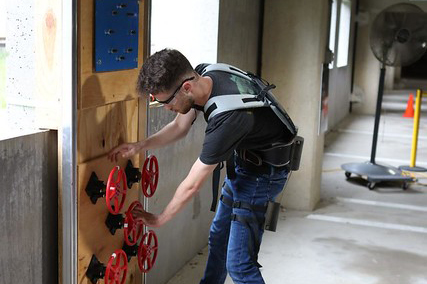News Story
Firefighter Exoskeleton Built by UMD Students Wins Second Place at ASTM International Games

Nick Salanitri ’25 performs challenges at the ASTM International Exo Games.
A team of students at the University of Maryland Honors College won second place at this year’s ASTM International Exo Games, boasting an exoskeleton design for firefighter use at a Philadelphia competition earlier this month.
Team EXO, part of the university’s Gemstone Program, rose in a competition where the task was to design exoskeleton technologies with applications to emergency response and unstructured environments, including law enforcement, firefighting, bomb squads, urban search and rescue, and Emergency Medical Technicians (EMTs). Their prototype, which aids firefighters by distributing weight more evenly, provides mechanical assistance to reduce physical burden for wearers. Their work was a collaboration with Department of Fire Protection Engineering Professor Peter Sunderland, who mentored the group through design challenges.
“This student team identified an excellent solution to the persistent problem of firefighter fatigue and injury.They have worked tirelessly for three years to design and build several prototypes. They work incredibly well together,” said Sunderland.
The team is formed by fire protection engineering senior Liam Smith ’25, who leads public relations efforts, as well as mechanical engineering major Connor Bosco ’25, bioengineering major Jess Mense ’25, aerospace engineering major Tom Bigot ’25, geology major Nick Salanitri ’25, electrical engineering major Donald Spriggs ’25, and mechanical engineering major Brett Ingram ’25, who act as research and administrative liaisons.
Team EXO, which secured an additional first place accolade in the design category, aims to create a device that reduces the physical burden of firefighters during emergency response, as research suggests that a leading cause of injuries for firefighters in the United States is the bodily strain and exertion from their equipment.
At the competition, Salanitri put the device to the test through a series of challenges emulating real-life scenarios, including lifting heavy boxes, navigating stairs, crawling through tunnels, and a mock bomb disposal exercise. Judges praised team EXO’s design for utilizing springs to enhance back support, which assisted wearers to stand back up—a crucial feature for firefighters during emergency response.
“Exoskeletons are hard to build and design because they have to fit the human body while enhancing mobility,” said Salanitri.
Moving forward, team EXO is eager to integrate the insights gained from the competition into their future work. They plan to continue developing their exoskeleton and exploring new avenues for application in first responder scenarios. Their success at the games demonstrates the potential impact of their innovative research on enhancing the capabilities of first responders.
This story first appeared on the University of Maryland Honors College website.
Published September 27, 2024









